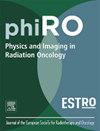In-vitro effects of modern radiotherapy regimes on cardiac implanted electrical devices
IF 3.3
Q2 ONCOLOGY
引用次数: 0
Abstract
Background and purpose
External Beam Radiotherapy (EBRT) of patients with Cardiac Implanted Electrical Devices (CIEDs) have guidelines developed over many decades, during which both technologies have advanced. Consequently, guidelines may not reflect modern device interactions. Asynchronous modes, with pace sensing and shocks turned off whilst regulating pacing output, is used routinely for MRI scanning and could reduce risks for pace sensing errors in radiotherapy. Evidence is limited on modern radiotherapy using high dose, high doserate beams, with CIEDs in asynchronous mode. We present the effects of irradiating modern CIEDs using contemporary radiotherapy regimes.
Materials and methods
One hundred and sixty explanted CIEDs were irradiated, to corroborate historical findings for modern devices in normal operational modes, and explore effects when in asynchronous mode. Regimes knowingly detrimental to CIEDs; 48 Gy single fraction, neutron producing, alongside clinically relevant regimes of 60 Gy in 5 fractions using 10 MV flattening filter free [FFF] beams at clinical, and maximal dose rates.
Results
No significant changes occurred to pacing voltages from 60 Gy in 5 fractions 10 MV FFF deliveries in asynchronous mode.
No evidence supported restricting 6 MV flattened beams for CIED patients, including defibrillation capable devices.
Conclusions
This study demonstrates asynchronous mode can reduce the frequency of CIED malfunctions during EBRT. However, clinical context, risks and benefit must be evaluated per patient. While some current guidelines potentially compromise plan quality to reduce dose to the CIED, the use of asynchronous mode may provide planning options, which more closely align to non-CIED cases.
现代放射疗法对心脏植入电装置的体外影响
背景和目的心脏植入电装置(cied)患者的外束放疗(EBRT)指南已经制定了几十年,在此期间两种技术都取得了进步。因此,指南可能无法反映现代设备的交互。异步模式,在调节起搏输出的同时关闭速度感应和冲击,常规用于MRI扫描,可以降低放射治疗中速度感应错误的风险。证据有限的现代放疗使用高剂量,高剂量的光束,与cied在异步模式。我们介绍了使用现代放射疗法照射现代cied的效果。材料和方法对160个外植的cied进行辐照,以证实现代器件在正常工作模式下的历史发现,并探索在异步模式下的影响。有意对ied有害的制度;48 Gy单组分,产生中子,以及临床相关的5组分60 Gy方案,在临床和最大剂量率下使用10 MV无压扁滤波器[FFF]光束。结果在异步模式下,从60 Gy开始,分5次10 MV FFF给药,起搏电压无显著变化。没有证据支持限制CIED患者使用6 MV扁平束,包括除颤装置。结论异步模式可以降低EBRT过程中CIED故障的发生频率。然而,临床背景、风险和益处必须对每位患者进行评估。虽然目前的一些指南可能会降低计划质量,以减少对CIED的剂量,但使用异步模式可能会提供更符合非CIED病例的计划选择。
本文章由计算机程序翻译,如有差异,请以英文原文为准。
求助全文
约1分钟内获得全文
求助全文
来源期刊

Physics and Imaging in Radiation Oncology
Physics and Astronomy-Radiation
CiteScore
5.30
自引率
18.90%
发文量
93
审稿时长
6 weeks
 求助内容:
求助内容: 应助结果提醒方式:
应助结果提醒方式:


